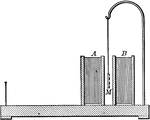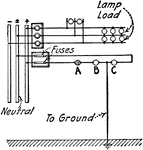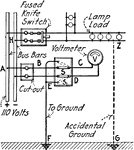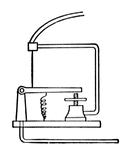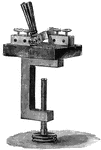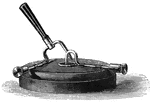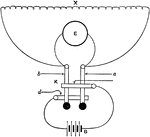This science ClipArt gallery offers 245 illustrations of basic concepts, experiments, apparatus, and systems proving properties and concepts in electricity.

Faraday Experiment
"Faraday used in his experiments two identical pieces of apparatus, which were vertually two spherical…
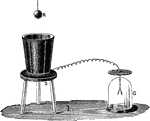
Faraday's Ice Pail Experiment
"Faraday's ice pail experiment. An ice pail P connected with gold leaves of an electroscope C, is placed…

Four-Plate Machine
"Machines of this kind may be constructed with as many pairs of plaes, combs, and brushes as can be…

Frictional Electric Machine
Now known as electrostatic generators, the Frictional electric machine produces static electricity at…
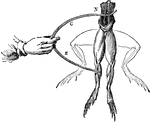
Frog Experiment
"Galvani found that whenever the nerves of a frog's leg were touched by one metal and the muscles by…
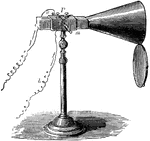
Funnel-shaped Brass
A funnel-shaped piece of brass is placed over the ends of a galvanometer when the resistance is equal…
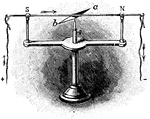
Galvanometer
A galvanometer is a type of ammeter; an instrument for detecting and measuring electric current. It…
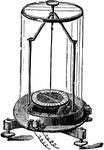
Astatic galvanometer
"The galvanometer is an instrument for determining the strength of an electric current by means of the…
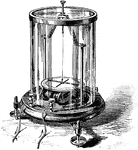
Astatic Galvanometer
"Astatic galvanometer, an instrument which consists of a pair of similar needles magnetized, with their…

Differential Galvanometer
"The galvanometer consists of two distinct coils of wire, each having the same resistance, and having…
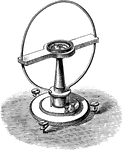
Tangent galvanometer
"The galvanometer is an instrument for determining the strength of an electric current by means of the…
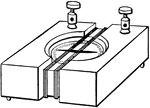
Galvanoscope
"Secure the two ends of the wire by double-pointed tacks. Place a small pocket compass upon the block…

Idiostatic Gauge
An illustration of an idiostatic gauge which determines the charge in the condenser.

Current Leakage Around Generator
"Illustration showing the path of leakage current caused by ground due to damp insulation." —Croft…

Current Leakage Around Generator
"Illustration showing current leakage through the rame of a machine which is insulated from the ground."…

Method For Drying Out a Generator
"Method of drying out a generator by short-circuiting the armature leads through a water rheostat."…
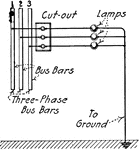
Cutout Ground Detector for Three Wire Circuit
"Cut-out ground detector using lamps for a three wire circuit." —Croft 1920
Henleys Electrometer
"The electrometer of Henley, sometimes called Henley's quadrant Henley electrometer, may be taken as…

Induced Charge
"Experiment illustrating the nature of an induced charge. The apparatus consists of a metal ball and…

Induction Coil
"The induction coil is...often called the Rhumkorff coil. Receiving a large current of small electromotive…

Induction Coil
"The induction coil is...often called the Rhumkorff coil. Receiving a large current of small electromotive…
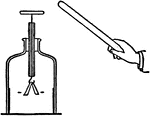
Electrostatic Induction
"Experiment to illustrate electrostatic induction. The leaves will diverge, ever though the charged…
Electrostatic Induction
"Bring a metallic sphere postively charged near an insulated cylindrical conductor with hemispherical…

Electrostatic Induction
"Suspend two egg-shell conductors as shown. Be sure that the shells are in contact. Bring an electrified…

Induction Machine
"Machine used to generate electricity by induction using transformed kinetic energy from the crank."…

Instrument for Testing Batteries
This is the instrument used for measuring the electrical potential difference between two points in…
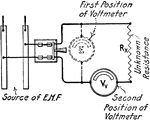
Measuring Insulation Resistance
"Illustrating method of measuring insulation resistance." —Croft 1920

Measure Armature Insulation Resistance
"Testing the insulation resistance of an armature." —Croft 1920
Measure Insulation Resistance of Motor
"Testing the insulation resistance of a motor or generator from its winding to ground." —Croft…

Leyden Jar
"The most common and, for many purposes, the most convenient form of condenser is the Leyden jar. This…

Jump start ignition
"Diagram of battery and coil connections for jump spark iginition as applied to a motor cycle." —…

Connexions of Kelvin Ampere Balance
"The connexions of all these six coils are such that when a current is passed through the whole of the…

Lanes Jar
"D is a Leyden jar, fastened to a stand in such a way that its outer armature can be insulated or connected…
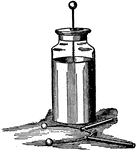
Leyden Jar
"The Leyden jar and discharger. Its discovery is attributed to the attempt of Musschenbrock and his…
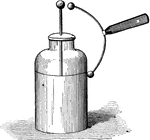
Leyden Jar
"...consists of a glass jar coated inside and outside with tinfoil, or some other thin sheet metal,…

Leyden Jar Connected to Terminals
"Then connect a Leyden jar to the terminals, as shown." -Avery 1895

Diagram of a Leyden jar
"The most common and, for many purposes, the most convenient form of condenser is the Leyden jar. This…

Wimshurst Electric Machine
"The essential parts of an ordinary Wimshurst machine, are two ordinary drums. On each plate are fixed…
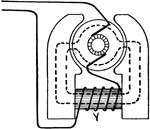
Bipolar field magnet
"Salient pole, bipolar field magnet with single coil wound around the yoke." — Hawkins, 1917

Bipolar field magnet
"Consequent pole bipolar field magnet with two coils on the core." — Hawkins, 1917
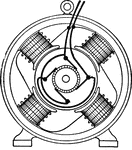
Multi-polar field magnet
"Modern dynamo with four consequent pole field magnets. In this construction the ring shaped yoke also…

Solenoidal magnet
"The polarity of the solenoidal magnet may be determined by holding it in the right hand so that the…
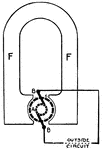
Magneto
"In a magneto the field magnets are permanently magnetized. The strength of the magnet field of a magneto…




